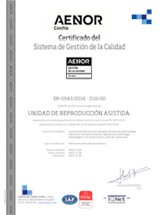The managing director of the Basque Institute of Fertility, Yosu Franco, exposed in the Master of Reproductive Medicine and Genetics the current procedures that are used when there is a male pathology
 The sperm DNA fragmentation is presented as a new parameter of sperm quality. Nowadays, there is much controversy about the importance of its study, as well as the influence that it can have on the fertilisation rates, implantation, pregnancy, miscarriage and embryo quality.
The sperm DNA fragmentation is presented as a new parameter of sperm quality. Nowadays, there is much controversy about the importance of its study, as well as the influence that it can have on the fertilisation rates, implantation, pregnancy, miscarriage and embryo quality.
This issue was addressed by the managing director of the Basque Institute of Fertility, Yosu Franco, in his paper “Sperm selection. Is it really effective? “, given to the students of the Master of Medicine and Genetics, jointly organized by the Clínica Vistahermosa Reproductive Biomedicine Chair, the Cell Biology Area of the Faculty of Medicine and the Reproduction and Genetics Units at Hospital Clínica Vistahermosa in Alicante.
Franco claimed that when there is a male pathology “the sperm selection is essential to obtain sperm quality and achieve an optimal embryo, thus avoiding a miscarriage.” He explained that the new techniques used to select the best sperm cells are decisive to increase the possibilities of success, since “the rate of chromosome alterations drops when passing through annexin columns, a procedure that eliminates those sperm cells that have the DNA fragmented, allowing the fertilisation to be performed with a high quality sperm”.
According to the specialist, the morphology, the DNA status and the existence in the cell membrane of markers that  determine sperm maturity are factors that define the sperm quality beyond its motility. Franco also mentioned the electrophoresis, which allows the selection of sperm cells based on their electronegativity and size of their genome; the observation of the birefringence, which presents the sperm cell with polarized light; the picsi method, which is useful in patients who have a good sperm motility but a high DNA fragmentation, and imsis, a technique that is performed with an electron microscope which allows the sperm cells to be observed with 6,600-12,000 magnifications and as well as determining its correct morphology: Oval head, straight tail, fixed nucleus and transparent colour.
determine sperm maturity are factors that define the sperm quality beyond its motility. Franco also mentioned the electrophoresis, which allows the selection of sperm cells based on their electronegativity and size of their genome; the observation of the birefringence, which presents the sperm cell with polarized light; the picsi method, which is useful in patients who have a good sperm motility but a high DNA fragmentation, and imsis, a technique that is performed with an electron microscope which allows the sperm cells to be observed with 6,600-12,000 magnifications and as well as determining its correct morphology: Oval head, straight tail, fixed nucleus and transparent colour.
All these techniques are indicated to perform ICSI (Intracytoplasmic Sperm Injection) when there is a male factor with low sperm quality, fragmented sperm DNA in high percentage, or failure in previous procedures of assisted reproduction with poor embryo quality and miscarriages.











